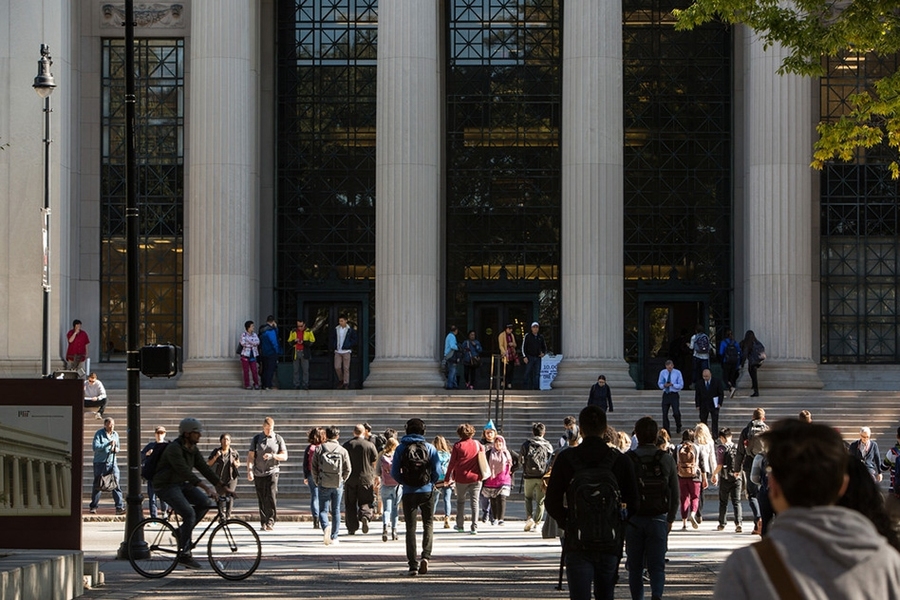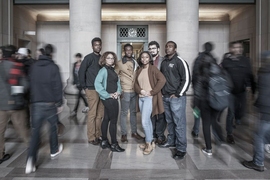Since a watershed meeting just over two years ago, when representatives from the Black Students’ Union and the Black Graduate Student Association met with President L. Rafael Reif, the administration has introduced a number of changes intended to enhance diversity and inclusion at MIT.
These changes have been guided by two sets of recommendations, one from the BSU and one from the BGSA, that emerged from this initial meeting. Many of the recommendations — particularly those involving orientation for incoming students, mental health services, implicit bias training, financial aid, and student surveys and data collection — have now been partially or completely implemented. Discussions are under way to address other recommendations for department-level actions, administration leaders have told MIT News.
The scope of individual recommendations has varied — from enhancing diversity orientation for incoming students to developing and implementing a 10-year plan to increase the number of graduate students from underrepresented minority groups — and thus so has the timeframe for responding to them, according to Vice President Kirk Kolenbrander.
“Many changes could be implemented relatively quickly, and they have been. Others must be addressed across departments that vary greatly in their size, organizational structure, and standard operating procedures, so these require creative thinking and a sustained effort,” Kolenbrander says.
A multifaceted response
Kolenbrander has convened an Academic Council working group, consisting of students, faculty, and senior officers, dedicated to addressing these recommendations. With DiOnetta Jones Crayton, the associate dean for undergraduate education and director of the Office of Minority Education, he has also convened another group to align staff who are advancing diversity and inclusion issues across the Institute. These groups have worked alongside Ed Bertschinger, the Institute’s community and equity officer, and Judy “JJ” Jackson, who joined MIT in 2016 as the diversity and inclusion officer.
The BSU and BGSA remain engaged in following up on their recommendations. The BSU’s political action committee, for example, is planning a survey to learn more about how the administration’s responses thus far have impacted students.
“MIT was very responsive and we’re very happy with the actions that have been taken, but we still want to make sure that the Institute remains accountable to the commitment that it’s made,” says third-year student Gabrielle Ballard, who co-chairs the BSU with third-year student Anthony Rolland and chairs the BSU political action committee.
“I hope that MIT will continue to engage with the students in order to figure out what the best plan is moving forward,” says Tsehai Grell, a BGSA member who has served on the group’s executive board and helped to draft the recommendations in 2015. “I’d like to see [Institute leadership] make sure student involvement continues. It has to be a unified effort. Everybody needs to be involved.”
Still other members of the MIT community have responded to the black student groups’ recommendations as well. For example, graduate student Ty Austin leads the diversity and inclusion subcommittee of the Graduate Student Council, which recently organized a network of students whose goal is to further diversity and inclusion efforts in academic departments.
When the BSU and BGSA presented their recommendations, the administration also invited other members of the MIT community to share additional ideas for making MIT a more welcoming, inclusive place. More than 90 are now under consideration or being actively addressed. For example, the Institute recently received permission from state authorities to launch a pilot program with four all-gender bathrooms on campus.
Enhancing mental health and counseling services
Both the BSU and BGSA have put forward recommendations for enhancing mental health and counseling services and hiring staff with expertise in race-based traumatic stress.
In October 2016, MIT hired Karen Singleton, who specializes in multicultural psychology and trauma, as chief of Mental Health and Counseling and associate medical director at MIT Medical. Three clinicians with expertise in race-based trauma have also been appointed: Cecil Webster Jr., Leslie Langston, and Erik Marks.
Recent activities by Mental Health and Counseling staff have included antioppression training for staff; the formation of a multicultural competency counseling team; development of a workshop series on the imposter phenomenon; a biweekly event called Let’s Chat@OME, which allows students to drop into the Office of Minority Education and talk with mental health and counseling staff; and biweekly therapy groups for graduate students of color.
Orientation and implicit bias training
The Office of Multicultural Programs and the Office of Graduate Education (OGE) made a number of changes to the orientation programs for undergraduate and graduate students in the last two years.
In fall 2016 and 2017, incoming first-year students participated in small focus-group conversations on diversity and inclusion, facilitated by a trained conversation leader. MIT also began making modifications in fall 2016 to the graduate student orientation, including a dedicated networking reception for graduate students from underrepresented minority groups to meet senior leaders, faculty, and returning graduate students, and to learn about campus resources. The graduate students of color welcome planning committee is composed of graduate students, and OGE staff are beginning to discuss additional changes for 2018.
Implicit bias training, which the BGSA recommended for faculty, staff, and students, was launched in 2017 in several areas of the Institute, including the Institute Community and Equity Office, the Teaching and Learning Lab, Human Resources, Academic Council, and some academic departments.
Surveys and data collection
Other student recommendations related to collecting and sharing data about the MIT student body, broken down by race and other identity groups, could inform other efforts to further diversity and inclusion at the Institute.
These recommendations have led, for example, to the publication of a diversity dashboard, in cooperation with the Institutional Research section of the Office of the Provost. Targeted questions have also been added to key student surveys and the results made public. And, the Office of the Registrar is publishing a report on the number of underrepresented minority students by course and year on its enrollment page, which is available to everyone in the MIT community with an MIT Certificate.
The BSU has also met with Stu Schmill, the dean of admissions and student financial services, to review data collected by that office and work together to plan new efforts to increase acceptance rates for students from underrepresented minority groups.
Financial aid
The BSU recommended increasing financial aid commitments to at least match peer institutions, reaffirming MIT’s commitment to keeping MIT education accessible through need-blind admission and a generous need-based financial system.
Over the last two years, MIT has increased financial aid expenditures by $23.4 million, from $97.3 million in FY16 to $120.7 million projected for FY18. The Institute has also reduced student self-help levels from $5,500 to $3,400 a year. MIT is one of only five U.S. colleges and universities that currently admit all undergraduate students without regard to their financial circumstances, award all financial aid based on need, and meet the full demonstrated financial need of all admitted students.
MIT continues to be unique in allowing low-income students to use Pell Grants to reduce or eliminate their self-help and summer savings expectations, and it guarantees that any family earning $90,000 or less will have scholarships that at least cover tuition. This guarantee serves more than one-third of MIT’s students.
Recruitment and retention
Both student groups have made recommendations around increasing diversity among graduate students and faculty, which involve a longer timeline. The BGSA, for example, recommended developing and implementing a 10-year plan to increase the number of underrepresented minority graduate students, in particular black graduate students.
“One thing that stands out to me is that to really increase the number of faculty members of color, we have to increase the number of graduate students of color. In the 2016-17 academic year, for example, only about 1 percent of MIT’s graduate students were black. We’d like to see a very concerted, coordinated effort to recruit graduate students of color,” says Candace Ross, a member and former president of the BGSA.
Thus far, every academic department has posted an online statement affirming its commitment to students’ health, diversity, and inclusion. Implementation of a longer-term plan is more complex and requires departmental customization, as MIT departments range widely in terms of size, organization, and recruitment and retention practices. A review of personnel in each department, to assess what may be feasible, is being considered, according to Jackson.
The BSU is keen to see how the departmental statements are put into practice, says Ballard: “Holistically, the goal would be seeing more students and faculty from underrepresented groups in those departments, and seeing [inclusionary practices extend even further], for example when professors are talking about people who have contributed to the field. It’s important for everyone to see that there’s a diverse range of voices that are in the STEM and humanities fields.”
“This is something that going forward we want to keep in mind, that diversity and inclusion doesn’t just stop at who you see. It’s what you’re talking about, the conversations you’re having,” she adds.
OGE has addressed the BGSA recommendations on multiple fronts. Staff have implemented a Graduate Diversity Ambassador program, increasing MIT’s presence at recruitment conferences across the country and providing personalized advice on MIT graduate applications to alumni of the MIT Summer Research Program (MSRP General) and CONVERGE.
With input from the Office of the General Counsel, OGE implemented an expanded fee waiver policy during the 2016 application cycle to remove potential financial barriers for applicants who may not have considered MIT.
OGE is also renewing its commitment to the University Center for Exemplary Mentoring, which provides professional development activities to prepare doctoral students from underrepresented minorities for careers in academia. The OGE’s “Ignite Your Vision,” a monthly discussion series facilitated primarily by MIT faculty and alumni of color, touches upon general professional-development topics and provides an opportunity for graduate students to learn from the experiences of representatives from diverse career paths in industry, education, health care, and government.
In recent months, OGE has hired new team members to serve MIT’s graduate student community. Assistant Dean Suraiya Baluch joined the Graduate Personal Support office, and is helping to expand the support network for graduate students. Two diversity staff positions have been filled in order to focus on maintaining MIT’s diversity recruitment efforts and provide bandwidth for the office to revamp its involvement in professional development. OGE plans to continue its collaboration with several academic departments and administrative offices at MIT, including Global Education and Career Development, to devise a targeted approach to addressing the BGSA’s recommendation that the Institute provide tailored resources to help graduate students from underrepresented minority groups compete successfully on academic and professional job markets.
A sustained effort
Members of the MIT community who have been engaged in furthering diversity and inclusion at the Institute agree that this work will need to continue for years to come.
“The students have not given up on these recommendations; they are not going to let them disappear,” Crayton says. “We have to continue to be thoughtful about them. If there are things we cannot do, or cannot do right away, we have to be very transparent about sharing that information. That’s what will build stronger relationships.”
Work on inclusion is inherently a constant process, Jackson says.
“When I look at these recommendations, what I see the students are looking for is an equitable opportunity for everyone to be free and unfettered to do their best at MIT and make a contribution to the community,” she says. “Inclusion does not first demand that you be like somebody else. It says whoever you are, bring the best of you into the community and let’s together help to make MIT a better place if MIT is going to help make a better world.”








